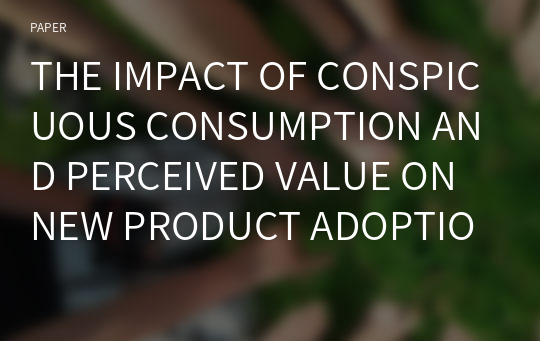THE IMPACT OF CONSPICUOUS CONSUMPTION AND PERCEIVED VALUE ON NEW PRODUCT ADOPTION INTENTION: THE MODERATING ROLE OF CREATIVITY-SEEKING PERSONALITY
* 본 문서는 배포용으로 복사 및 편집이 불가합니다.
서지정보
ㆍ발행기관 : 글로벌지식마케팅경영학회(GFMC)
ㆍ수록지정보 : GFMC Session1
ㆍ저자명 : Meixiang Cui, Subin Im
ㆍ저자명 : Meixiang Cui, Subin Im
영어 초록
Along with the growth of disposable income and the improvement of consumers’ living condition, consumers are no longer satisfied only with the fulfillment of functional needs of products. Instead, they seek to meet higher level of demand such as emotional and symbolic needs when consuming products. One reflection of this kind of pursuit in consumer behavior is “conspicuous consumption”, which is the tendency for individuals to enhance their image and communicate status to others through overt consumption of possessions (O’Cass & McEwen, 2004).Moreover, the emergence of social networking service (SNS) has boosted the phenomenon of such overt consumption. For example, a consumer who bought a new luxury sports car uploads a photo of his/her car on Facebook to show off his/her wealth, status, uniqueness, taste, etc. In this context, if a product is scarce due to a limited supply, then consumers might use the product for conspicuous consumption (Gierl & Huettl, 2010). Thus, it can be inferred that consumers who have conspicuous consumption tendency will be attracted by new product which is scarce in its early diffusion process. Moreover, the literature has added new content to conspicuous consumption with the development of social economy and value. Consumption value goes far beyond satisfying functional needs, and consumption and possessions are regarded as the extension of the self (Belk, 1988). Hence, consumers would be eager to present and show off their “extended self” on SNS using new products. As a consequence, this research aims at exploring the relationship and internal mechanism between the new paradigm of conspicuous consumption and consumers’ new product adoption intention, mediated through perceived consumption value.
Different traits of consumers and resulting value perceptions are influential on consumer adoption behavioral intention and outcomes (e.g., Kastanakis & Balabanis, 2014). Despite the fact that identifying and adequately meet the needs of target consumers is essential in new product success, current literature still lacks understanding on how consumers perceive value of new products based on their needs for conspicuous consumption in adopting new products. Moreover, even though there are some evidence in the literature showing that consumers with high needs for conspicuous consumption accept new products more quickly, there is limited guideline for managers for how and why different perspectives of conspicuous consumption tendency affect new product adoption intention through perceived value of the product. In addition, consumer behavior literature of conspicuous consumption has overemphasized the role of status seeking without fully understanding other motives and needs for it. Accordingly, we will start by examining different types of conspicuous consumption tendencies and studying how they affect different value perceptions, which lead to new product adoption intention.
A large number of studies from various disciplines have defined “conspicuous consumption” differently. Earlier, Veblen (1899) proposed the term “conspicuous consumption” to describe the behavior of rich American people who spent a significant portion of their time and money on unnecessary and unproductive leisure expenditures. As indicated, in early days, “conspicuous consumption” was thought to be only occurred to the upper class of the society that wishes to display wealth or status through luxury consumption. However, Mason (1988) pointed out that conspicuous consumption is not only associated with the rich and privileged, but is a worldwide phenomenon that is easily observed at all social and economic levels. Moreover, recent research advocates that conspicuous consumption is not only about displaying wealth, but also about delivering self-images and enhancing social standing through consumption. The symbolic meaning of products is commonly used as an outward expression of consumer self-concept and connection to the society (Chaudhuri & Majumdar, 2006). The motives to show their social status, unique taste or conformity trigger overt consumption of different kinds of goods to satisfy the need of belonging, increase their popularity, as well as be highly respected, admired, or envied (Gierl & Huettle, 2010).
Drawing from current literature (e.g., Chaudhuri & Majumdar, 2006; Chen, Yeh, & Wang, 2008; Gierl & Huettl, 2010; O’Cass & McEwen, 2004; Shukla, 2008), this research defines conspicuous consumption as the tendency for individuals to enhance their image and communicate status to others through overt consumption, and proposes it to be a multidimensional concept consists of three dimensions namely ostentation of a high social status (a superior position within a social hierarchy), demonstration of uniqueness (differences from people belonging to the same social group), and demonstration of conformity (similarity to people belonging to a certain social group). We aim at examining the individual differences in three different conspicuous consumption tendencies and how they are related to new product adoption intention.
It is important to study new product success from the consumer’s perspective because the success of new product eventually depends on the decisions of consumers to adopt or reject the new product (Im, Bhat, & Lee, 2015). According to Hirschman (1980), innate personality of the consumer has an important influence on whether to adopt new product or not. Moreover, Venkatesh and Brown (2001) found that relevant others such as friends, family, and other important connections can influence the adoption decision. As such, those who are influenced by the people around them will choose products that can convey an image congruent with the social image they wish to project. (Sheth, Newman, & Gross, 1991). New products, depending on their characteristics and types, can be used to show social status, uniqueness, or conformity. When the new product is first launched in the market, it is often released at a high price, though it is not a necessity to most consumers.
Thus, adopting the high priced but unnecessary new products or frequently upgraded products in a certain category can signal economically rich status. In addition, consumers adopt new products to demonstrate their needs for uniqueness due to the scarcity in early diffusion process. Finally, new product can also help consumers conform to a certain group they wish to belong. For example, when most of a consumer’s friends or colleagues have adopted iPhone, he/she also is willing to adopt iPhone in order to assimilate with the group member and achieve a sense of belonging. In conclusion, there might be positive relationships between consumers’ tendency to demonstrate high social status, uniqueness and conformity and new product adoption.
Im et al. (2015) argued that consumers’ evaluation of or attitude toward a product and ultimate decision to adopt depends on their perceptions of the product’s value. Thus, perceived value may act as an important determinant in new product adoption. Besides, now that perceived value is derived from subjective evaluation and judgement of consumers, different consumers involved in the purchasing process can vary on the perceptions of new products (Perkins, 1993). Moreover, individuals tend to perceive what they need and want while ignoring other irrelevant stimuli around (Schiffman & Wisenblit, 2016). Since consumers with three different types of conspicuous consumption tendency have different needs and wants, they will respond differently to the value offered by products. Thus, we propose the mediating role of perceived value between conspicuous consumption and consumers’ intention of new product adoption.
Another important individual level variable that impacts perception of new product is creativity-seeking personality, which refers to the tendency to seek information that is novel and meaningful (Im et al., 2015). Since novelty and meaningfulness are important features of innovation that are embedded in new products, consumers who seek for them are more likely to appreciate the new products more. Thus, we assert that creativity-seeking personality is also important in forming new product adoption behavior. Moreover, according to Im et al. (2015), novelty affects perceived hedonic value while meaningfulness influences perceived utilitarian value. This research attempts to explore the moderating role of creativity-seeking personality on the relationship between conspicuous consumption and perceived value to reveal the synergy effect of conspicuous consumption and creativity-seeking personality. Creativity-seeking personality consists of a novelty-seeking personality (a personal tendency related to the willingness to seek information that is new and different), and a meaningfulness-seeking personality (a personal tendency related to the willingness to seek information that is useful and relevant) (Hirshman, 1980; Im et al., 2015). Specifically, we propose that demonstration of uniqueness has a stronger impact on hedonic value among consumers with high level of novelty-seeking personality and demonstration of conformity has a stronger impact on utilitarian value among consumers with high level of meaningfulness-seeking personality.
As such, drawing on the existing literature about conspicuous consumption, creativity-seeking personality, perceived value and purchase intention, this research proposes the mediating role of perceived value through which conspicuous consumption impact consumers’ new product adoption intention. In the meantime, this research explores the moderating role of creativity-seeking personality on the effect of conspicuous consumption on perceived value of new products. Accordingly, our research model is given as demonstrated in Figure 1.
We expect the positive relationship between conspicuous consumption and new product adoption intention. Moreover, we predict perceived value mediates the impact of conspicuous consumption on new product adoption intention whereas creativity-seeking personality plays a moderating role. This research has several academic contributions and managerial implications. First, this research distinguished three types of conspicuous consumption from modern perspective including ostentation of a high social status, demonstration of uniqueness, and demonstration of conformity. By testing the impact of three types of conspicuous consumption on new product adoption intention, this study extends existing literature by identifying drivers of new product adoption. Second, it shed light on a mediating mechanism of perceived value through which conspicuous consumption conveys its effect on new product adoption. Third, it identified the moderating role of novelty-seeking personality and meaningfulness-seeking personality on the effect of conspicuous consumption on perceived value. Though we are proposing the theoretical model in Figure 1 based on prior literature in this paper, we expect to empirically validate the relationships in the model by collecting data through multiple experiments using Mechanical Turk. Before the data collection, we will go through the IRB approval for the subject pool and research design.
As for managers, they can flexibly apply the consumers’ tendency of conspicuous consumption and creativity-seeking personality as market segmentation tool and implement the appropriate marketing strategy to improve new product adoption behavior for better new product performance. First, managers should be aware that conspicuous consumers are not a homogeneous group. They need to understand the heterogeneous drivers of consumers’ motives regarding conspicuous consumption and formulate appropriate marketing strategy to segment them. Second, this research provides some guidelines in new product promotion. For example, advertisement of the new products can highlight the different kinds of value when targeting consumers with different types of conspicuous consumption tendency. Third, as for sales people, they can provide novel product information to consumers who have tendency to demonstrate uniqueness and provide meaningful product information to consumers who have tendency to demonstrate conformity to increase purchase intention of consumers.
참고 자료
없음태그
"GFMC Session1"의 다른 논문
 FAST AND SLOW FASHION BRANDS IN DEVELOPING SUSTAINABLE ..6페이지
FAST AND SLOW FASHION BRANDS IN DEVELOPING SUSTAINABLE ..6페이지 “WHAT IF A CELEBRITY AND A BRAND CO-CREATE A NEW COLLEC..7페이지
“WHAT IF A CELEBRITY AND A BRAND CO-CREATE A NEW COLLEC..7페이지 THE INSTAGRAM’S STRATEGY IN ENGAGING THE CUSTOMER’S LOY..3페이지
THE INSTAGRAM’S STRATEGY IN ENGAGING THE CUSTOMER’S LOY..3페이지 THE PARTICULARITIES OF NEW PRODUCT DEVELOPMENT IN THE T..5페이지
THE PARTICULARITIES OF NEW PRODUCT DEVELOPMENT IN THE T..5페이지 THE LONE CHOCOLATE BAR: THE INFLUENCE OF PERCEIVED SCAR..6페이지
THE LONE CHOCOLATE BAR: THE INFLUENCE OF PERCEIVED SCAR..6페이지 ADS AS WORKS OF ART: MEASURING ADVERTISING IMMERSION3페이지
ADS AS WORKS OF ART: MEASURING ADVERTISING IMMERSION3페이지 ECONOMIES OF SMALL: NICHE STRATEGIES AND SUCCESS FACTOR..8페이지
ECONOMIES OF SMALL: NICHE STRATEGIES AND SUCCESS FACTOR..8페이지 THE INFLUENCE OF ONLINE CUSTOMER REVIEWS ON RETAILERS' ..6페이지
THE INFLUENCE OF ONLINE CUSTOMER REVIEWS ON RETAILERS' ..6페이지 IS THE ARTIFICATION PROCESS PERCEIVED BY FINAL CONSUMER..6페이지
IS THE ARTIFICATION PROCESS PERCEIVED BY FINAL CONSUMER..6페이지 THE ODD EVEN PRICE PARADOX IN THE FASHION LUXURY SECTOR6페이지
THE ODD EVEN PRICE PARADOX IN THE FASHION LUXURY SECTOR6페이지


























